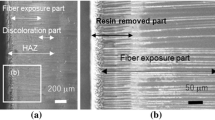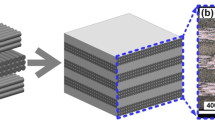Abstract
Over-melting and vaporization of resin matrix are usually found along a cut in the laser machining of carbon fiber reinforced plastic (CFRP). This is considered as the heat-affected zone (HAZ) and it has to be minimized to avoid the delamination of CFRP laminates. This paper presents the use of water flow to cool down the CFRP during the laser machining process. A thin flowing water layer induced by the impingement of low-pressure waterjet was formed on the workpiece surface, where a laser beam performed the ablation underneath the water layer. With this technique, the excessive heat and cut debris can be carried away from the workpiece by water. In this study, the effects of laser traverse speed, orientation of carbon fiber, water flow rate, and flow direction on cut dimensions and HAZ size were experimentally investigated. Using high water flow rate can limit the expansion of HAZ and also assist the material removal. In addition, the water flow directed along the laser traverse direction can increase the cut depth. The groove aspect ratio produced by the presented technique was found to be the same level as the laser ablation in air but the HAZ size was 20% smaller than the dry ablation. A predictive model for cut depth based on energy balance was also developed and analyzed in this study. The experimental findings and theoretical model presented in this work could enable a better understanding of the laser ablation in the flowing water layer and highlight the potential use of this technique for processing CFRP and other similar materials.
















Similar content being viewed by others
References
El-Hofy MH, El-Hofy H (2018) Laser beam machining of carbon fiber reinforced composites: a review. Int J Adv Manuf Technol 101:2965–2975. https://doi.org/10.1007/s00170-018-2978-6
Hu J, Zhu D (2018) Experimental study on the picosecond pulsed laser cutting of carbon fiber-reinforced plastics. J Reinf Plast Compos 37(15):993–1003. https://doi.org/10.1177/0731684418775807
Wolynski A, Herrmann T, Mucha P, Haloui H, L’huillier J (2011) Laser ablation of CFRP using picosecond laser pulses at different wavelengths from UV to IR. Phys Procedia 12:292–301. https://doi.org/10.1016/j.phpro.2011.03.136
Fujita M, Ohkawa H, Somekawa T, Otsuka M, Maeda Y, Matsutani T, Miyanaga N (2016) Wavelength and pulsewidth dependences of laser processing of CFRP. Phys Procedia 83:1031–1036. https://doi.org/10.1016/j.phpro.2016.08.108
Bluemel S, Jaeschke P, Suttmann O, Overmeyer L (2014) Comparative study of achievable quality cutting carbon fibre reinforced thermoplastics using continuous wave and pulsed laser sources. Phys Procedia 56:1143–1152. https://doi.org/10.1016/j.phpro.2014.08.029
Xu H, Hu J (2016) Study of Polymer matrix degradation behavior in CFRP short pulsed laser processing. Polymers 8(8):299
Leone C, Genna S, Tagliaferri V (2014) Fibre laser cutting of CFRP thin sheets by multi-passes scan technique. Opt Lasers Eng 53:43–50. https://doi.org/10.1016/j.optlaseng.2013.07.027
Herzog D, Canisius M, Schmidt-Lehr M, Hergoss P, Daniel C, Hallmann S, Emmelmann C, Scherner MV (2014) Investigations on the 3D laser cutting of CFRP using a nanosecond pulse fibre laser. Appl Polym Compos 2(4):177–192
Oh S, Lee I, Park Y-B, Ki H (2019) Investigation of cut quality in fiber laser cutting of CFRP. Opt Laser Technol 113:129–140. https://doi.org/10.1016/j.optlastec.2018.12.018
Tangwarodomnukun V, Likhitangsuwat P, Tevinpibanphan O, Dumkum C (2015) Laser ablation of titanium alloy under a thin and flowing water layer. Int J Mach Tools Manuf 89:14–28. https://doi.org/10.1016/j.ijmachtools.2014.10.013
Tangwarodomnukun V, Chen HY (2015) Laser ablation of PMMA in air, water, and ethanol environments. Mater Manuf Process 30(5):685–691. https://doi.org/10.1080/10426914.2014.994774
Krstulovic N, Shannon S, Stefanuik R, Fanara C (2013) Underwater-laser drilling of aluminum. Int J Adv Manuf Technol 69(5-8):1765–1773
Iwatani N, Doan HD, Fushinobu K (2014) Optimization of near-infrared laser drilling of silicon carbide under water. Int J Heat Mass Transf 71:515–520. https://doi.org/10.1016/j.ijheatmasstransfer.2013.12.046
Xu JY, Hu H, Lei YL (2014) Morphological features of silicon substrate by using different frequency laser ablation in air and water. Appl Surf Sci 317:666–671. https://doi.org/10.1016/j.apsusc.2014.08.038
Tangwarodomnukun V, Wuttisarn T (2017) Evolution of milled cavity in the multiple laser scans of titanium alloy under a flowing water layer. Int J Adv Manuf Technol 92(1):293–302. https://doi.org/10.1007/s00170-017-0125-4
Tangwarodomnukun V, Dumkum C (2018) Experiment and analytical model of laser milling process in soluble oil. Int J Adv Manuf Technol 96(1):607–621. https://doi.org/10.1007/s00170-018-1648-z
Weber R, Hafner M, Michalowski A, Graf T (2011) Minimum damage in CFRP laser processing. Phys Procedia 12:302–307. https://doi.org/10.1016/j.phpro.2011.03.137
Liu X, Lienhard VJH, Lombara JS (1991) Convective heat transfer by impingement of circular liquid jets. J Heat Transf 113(3):571–582. https://doi.org/10.1115/1.2910604
Çengel YA (2007) Heat and Mass Transfer: A Practical Approach, 3rd edn. McGraw-Hill, New York
Tangwarodomnukun V (2016) Cavity formation and surface modeling of laser milling process under a thin-flowing water layer. Appl Surf Sci 386:51–64. https://doi.org/10.1016/j.apsusc.2016.06.011
Sun D, Han F, Ying W (2019) The experimental investigation of water jet–guided laser cutting of CFRP. Int J Adv Manuf Technol 102:719–729. https://doi.org/10.1007/s00170-018-03218-4
Nguyen TTP, Tanabe R, Ito Y (2016) Effects of liquid properties on the dynamics of under-liquid laser-induced shock process. Appl Phys Mater Sci Process 122(9). https://doi.org/10.1007/s00339-016-0358-3
Tamura A, Sakka T, Fukami K, Ogata YH (2013) Dynamics of cavitation bubbles generated by multi-pulse laser irradiation of a solid target in water. Appl Phys Mater Sci Process 112(1):209–213
Funding
This research was financially supported by the Thailand Research Fund and the Office of the Higher Education Commission, Ministry of Education, Thailand (Grant No. MRG6080010).
Author information
Authors and Affiliations
Corresponding author
Additional information
Publisher’s note
Springer Nature remains neutral with regard to jurisdictional claims in published maps and institutional affiliations.
Rights and permissions
About this article
Cite this article
Tangwarodomnukun, V., Khamwiset, K. & Qi, H. Investigation into laser machining of carbon fiber reinforced plastic in a flowing water layer. Int J Adv Manuf Technol 104, 3629–3645 (2019). https://doi.org/10.1007/s00170-019-04131-0
Received:
Accepted:
Published:
Issue Date:
DOI: https://doi.org/10.1007/s00170-019-04131-0




